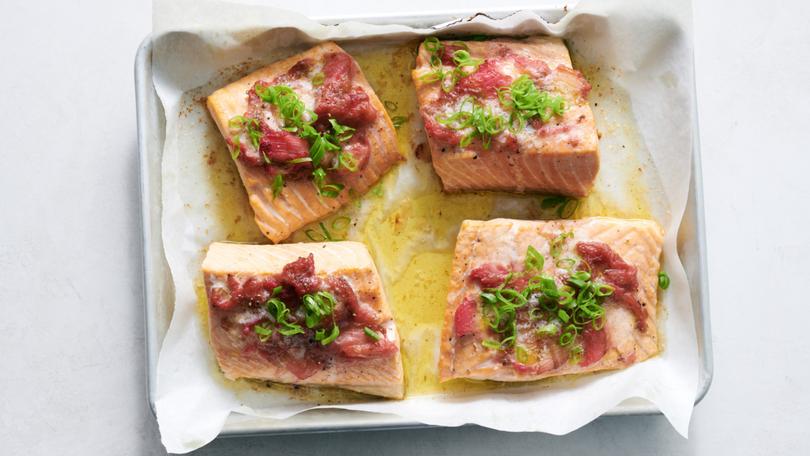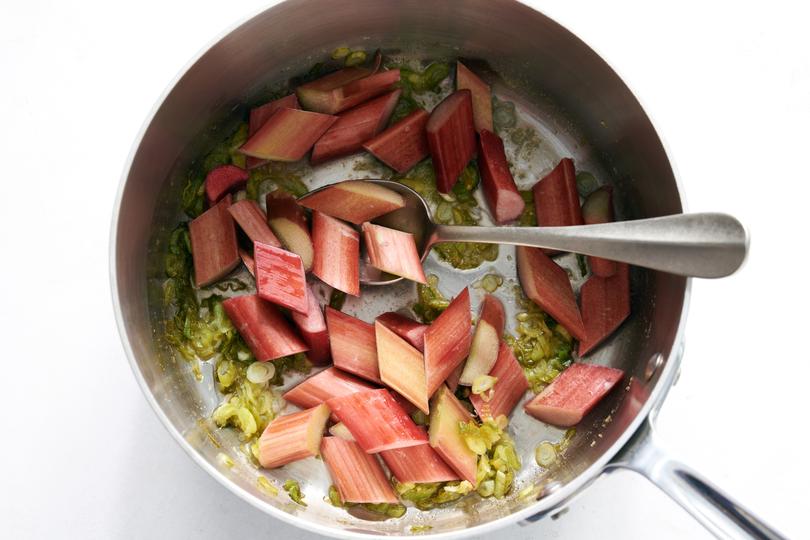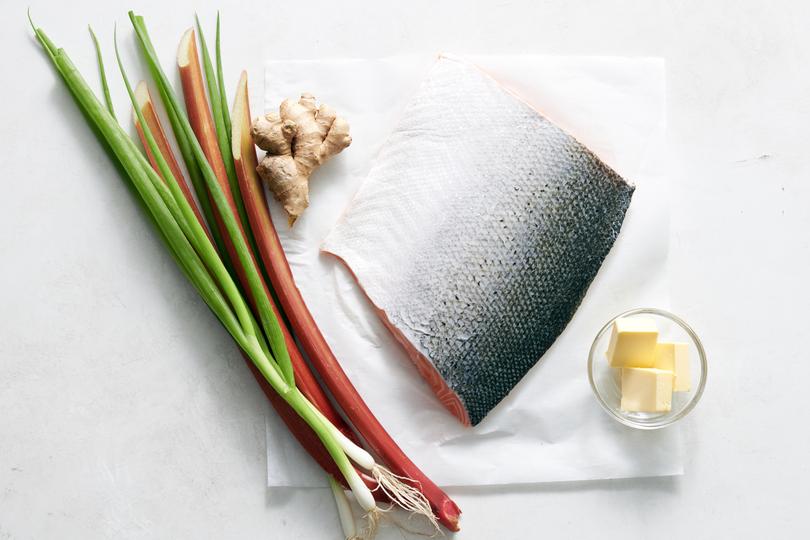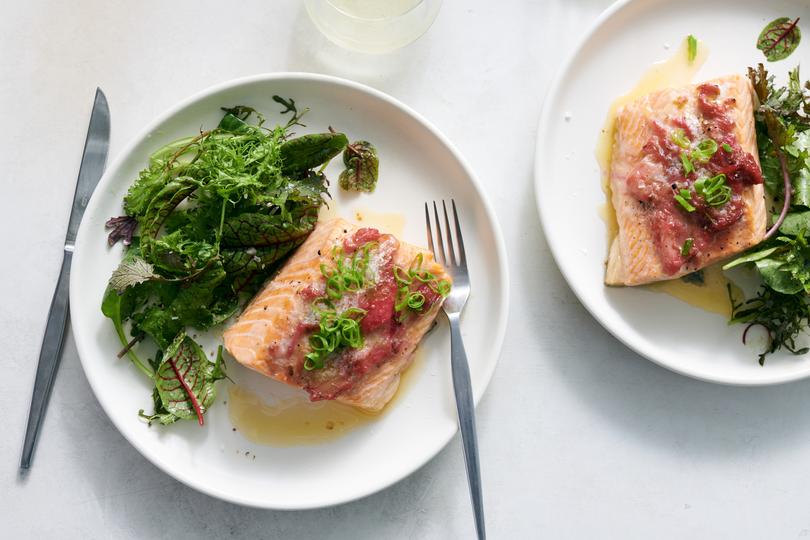New York Times recipe: This Sweet-Tart Roasted Salmon Is Ready in No Time

It’s easy to forget that rhubarb is a vegetable. Much of the time, you’ll find it buried, like a fruit, under an avalanche of sugar baked into a pie, crumble or cake, or maybe simmered into a compote.
But rhubarb isn’t just for dessert. With a bracing acidity reminiscent of citrus or pomegranate and no pesky seeds, it lends brightness and tang to all sorts of savoury dishes. It also adds body, cooking down into a thick sauce with a soft, pulpy texture much like tomato (an actual fruit), though sharper and pinker.
My favourite way to show off rhubarb’s savoury side is to use it as a foil for rich ingredients like fatty meats, buttery sauces and oily fish, which the stalks’ tartness cuts like a lightsaber. Think vinegar, but with precision and finesse.
Sign up to The Nightly's newsletters.
Get the first look at the digital newspaper, curated daily stories and breaking headlines delivered to your inbox.
By continuing you agree to our Terms and Privacy Policy.In this recipe, I match rosy rhubarb with even pinker salmon fillets for a simple, sunset-coloured weeknight meal.
First, simmer the rhubarb until it dissolves into a sauce, spiked with piquant fresh ginger, rice vinegar and spring onions. Adding just enough sugar tames the acidity, but feel free to stir in a little more if you like, as long as the sauce doesn’t slide into compote territory (in which case, save it for your morning yoghurt).

When the sauce reaches a perfect balance of tart and sweet, spoon some over the fish fillets before roasting. This allows the rhubarb filaments to singe and caramelise in the oven’s high heat. Then serve the rest of the rhubarb mix on the side for a fresher, zippier bite.
If you can find deeply red rhubarb stalks, they’ll give you the most vivid presentation. Green stalks, though just as flavourful, cook down to a listless beige and aren’t nearly as pretty. Still, that’s nothing a flamboyant garnish of spring onions couldn’t fix.
You can substitute other fillets for the salmon, but proceed carefully. You need a strongly flavored fish to stand up to this strident sauce. Assertive mackerel, swordfish, bluefish and tuna all stand their ground nicely. But mild fillets like cod, flounder and halibut will be quickly overwhelmed. Rhubarb is not for delicate proteins.
I love this dish on a bed of buttery rice, which absorbs the flavors of the salmon and the sauce and mellows them perfectly.
Rhubarb’s always a joyful dessert, but to really get to know it, bring it to dinner.
Recipe: Rhubarb Roasted Salmon
In this speedy, rosy weeknight dinner, a tart ginger-rhubarb sauce lends brightness to rich, buttery roasted salmon fillets. It’s used in two ways here. First, it’s spooned over the fillets before roasting, allowing the bits of rhubarb to singe and caramelise in the oven’s high heat. Then, more sauce is served alongside for a fresher, zippier bite. To balance the rhubarb’s astringency, a few tablespoons of sugar are stirred into the sauce, but feel free to adjust the amount to taste. It should strike a balance between tangy and sweet. For the pinkest, prettiest sauce, seek out the reddest rhubarb stalks you can find.
Serves 4
Total time: 25 minutes

Ingredients
3 spring onions, thinly sliced
2 tbsp granulated sugar, more to taste
1 tbsp rice vinegar, more for serving
½ tsp grated fresh ginger, more to taste
Salt
170g rhubarb, trimmed and sliced 2.5cm thick (1 ⅓ cups)
4 (170-230g) skin-on salmon fillets
Freshly ground black pepper
3 tbsp unsalted butter, cubed
Red-pepper flakes, for serving (optional)
Preparation
Step 1 Heat oven to 175C. Line a rimmed baking sheet with parchment paper, if you like, for easier clean-up.
Step 2 Set aside about 2 tablespoons of the onion greens for serving. In a medium saucepan, combine the remaining onions, sugar, vinegar, ginger and a pinch of salt. Bring to a simmer over medium heat and simmer until the sugar has dissolved.
Step 3 Add the rhubarb. Cover pan and cook, stirring occasionally, until the rhubarb is just tender, about 5 minutes. Remove pan from heat and, using a spoon or fork, mash the mixture until it falls apart into a chunky puree. Taste and add more sugar, vinegar, ginger and salt if needed. It should taste balanced between sweet, tangy and salty.
Step 4 Arrange salmon skin-side-down on the prepared baking sheet. Season lightly with salt and pepper. Spread half of the rhubarb mixture on top of the fillets (save remaining rhubarb for serving). Top fillets evenly with cubed butter. Roast for 8-13 minutes or until the salmon is just cooked through.
Step 5 Garnish the fillets with the reserved spring onion, red-pepper flakes (if using) and, if you like, a drizzle of rice wine vinegar. Serve with the remaining rhubarb sauce.
This article originally appeared in The New York Times.
© 2024 The New York Times Company

Originally published on The New York Times
